6CC544 Computing Technologies in Society Coursework 1 Analysis
VerifiedAdded on 2022/08/13
|7
|1219
|17
Homework Assignment
AI Summary
This document presents a comprehensive solution to a coursework assignment in Computing Technologies in Society (6CC544), addressing key concepts related to privacy, the evolution of the internet, and biometric technologies. The assignment begins by defining plagiarism and providing an example of proper source incorporation. It then explores the erosion of personal privacy by digital technologies, potential ramifications of increased biometric data use, and the student's interest in specific module topics such as privacy, the evolution of the internet, RFID, and biometrics. The solution further outlines a project proposal focusing on iris recognition using standard cameras, detailing the project's objectives and rationale. The assignment covers a range of topics including privacy values, internet evolution, the Internet of Things, and biometric systems, providing valuable insights into the ethical and technological aspects of these areas.
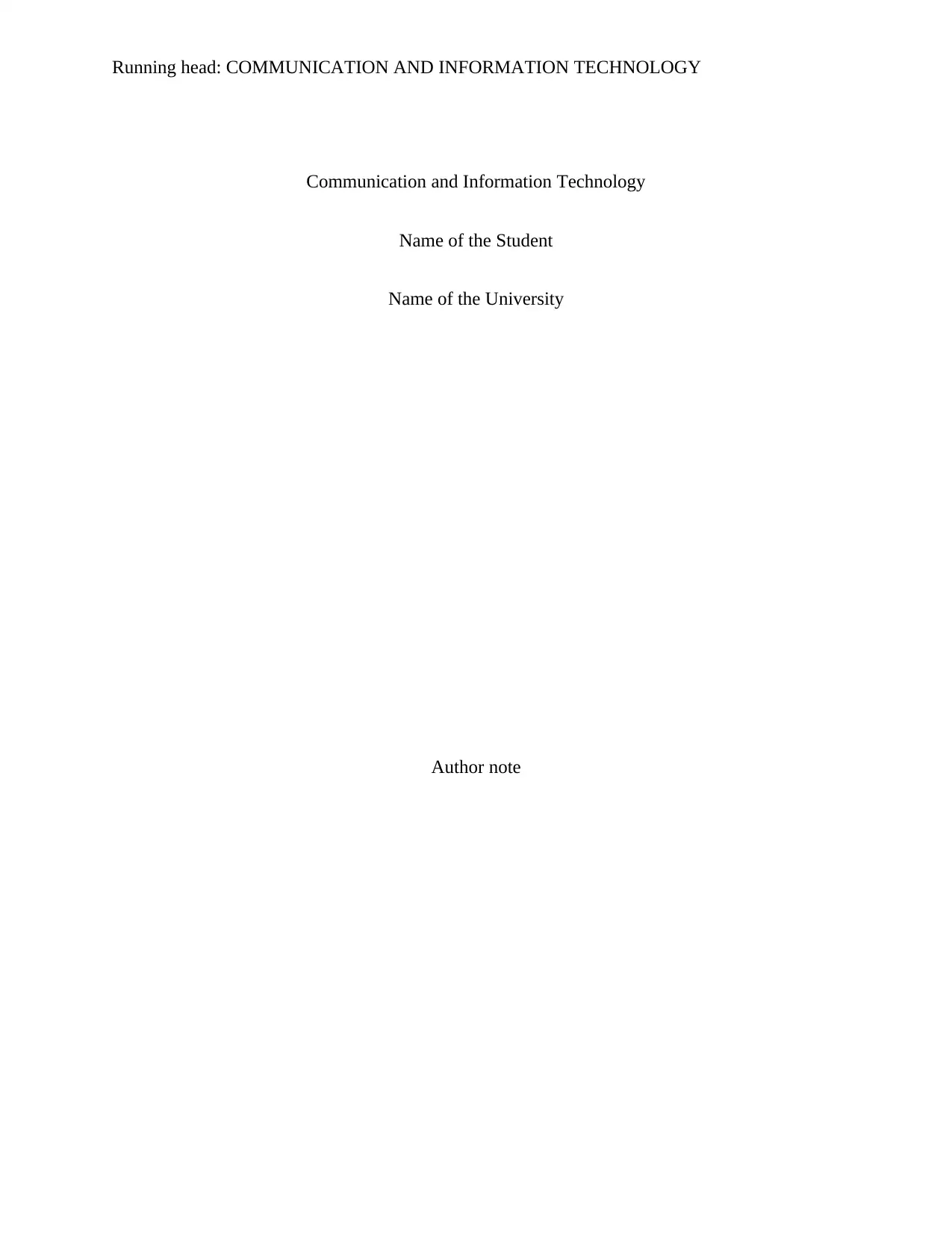
Running head: COMMUNICATION AND INFORMATION TECHNOLOGY
Communication and Information Technology
Name of the Student
Name of the University
Author note
Communication and Information Technology
Name of the Student
Name of the University
Author note
Paraphrase This Document
Need a fresh take? Get an instant paraphrase of this document with our AI Paraphraser
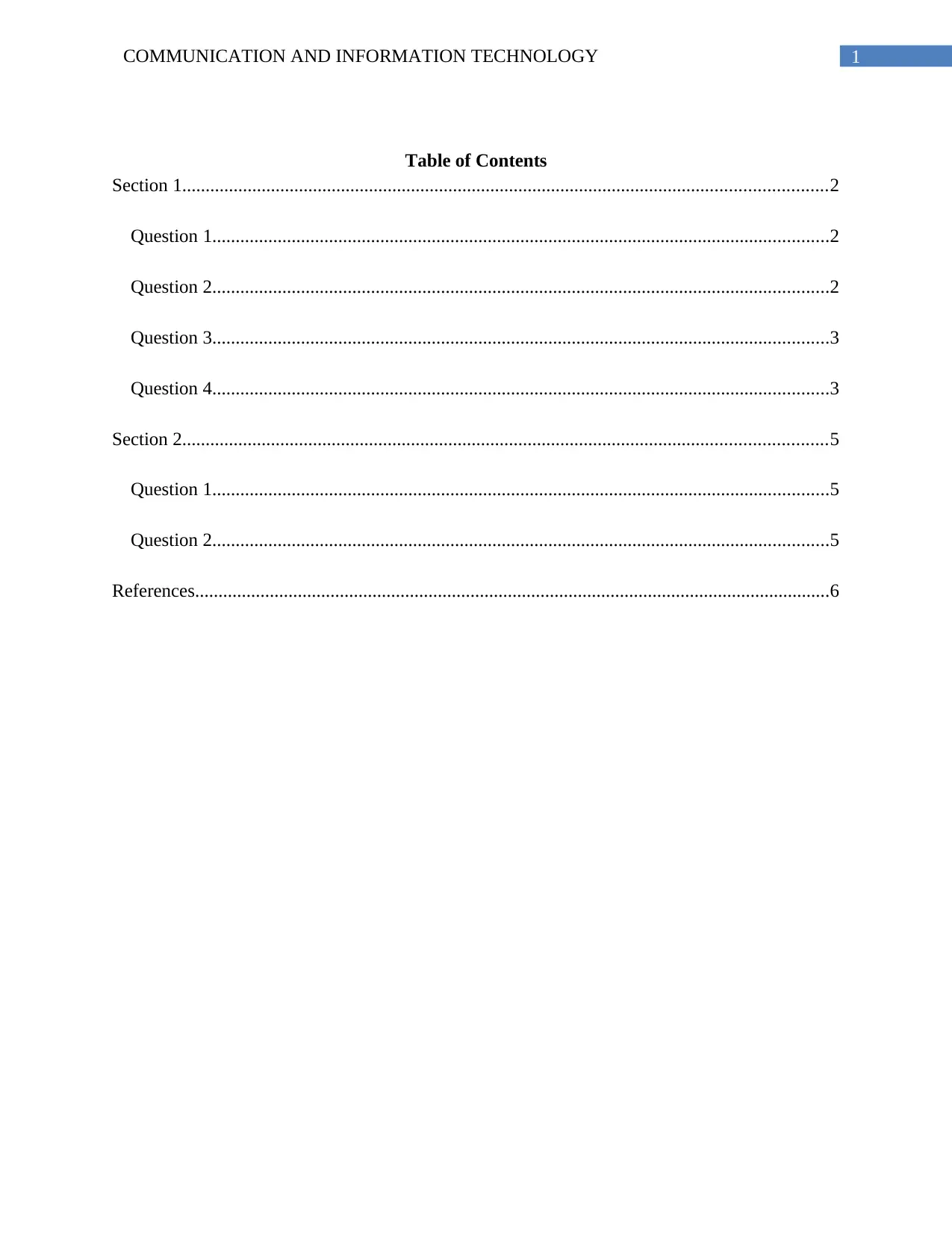
1COMMUNICATION AND INFORMATION TECHNOLOGY
Table of Contents
Section 1..........................................................................................................................................2
Question 1....................................................................................................................................2
Question 2....................................................................................................................................2
Question 3....................................................................................................................................3
Question 4....................................................................................................................................3
Section 2..........................................................................................................................................5
Question 1....................................................................................................................................5
Question 2....................................................................................................................................5
References........................................................................................................................................6
Table of Contents
Section 1..........................................................................................................................................2
Question 1....................................................................................................................................2
Question 2....................................................................................................................................2
Question 3....................................................................................................................................3
Question 4....................................................................................................................................3
Section 2..........................................................................................................................................5
Question 1....................................................................................................................................5
Question 2....................................................................................................................................5
References........................................................................................................................................6
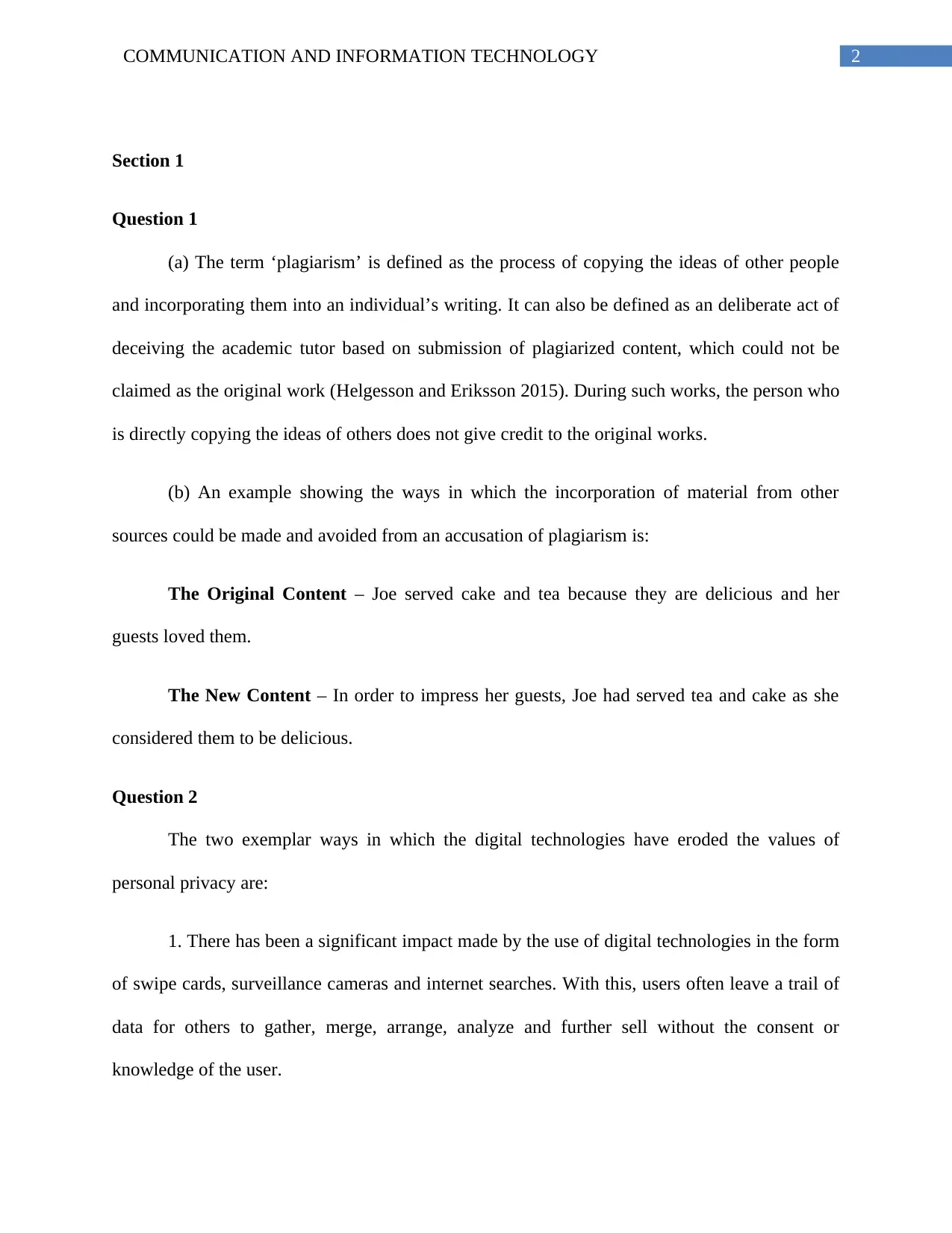
2COMMUNICATION AND INFORMATION TECHNOLOGY
Section 1
Question 1
(a) The term ‘plagiarism’ is defined as the process of copying the ideas of other people
and incorporating them into an individual’s writing. It can also be defined as an deliberate act of
deceiving the academic tutor based on submission of plagiarized content, which could not be
claimed as the original work (Helgesson and Eriksson 2015). During such works, the person who
is directly copying the ideas of others does not give credit to the original works.
(b) An example showing the ways in which the incorporation of material from other
sources could be made and avoided from an accusation of plagiarism is:
The Original Content – Joe served cake and tea because they are delicious and her
guests loved them.
The New Content – In order to impress her guests, Joe had served tea and cake as she
considered them to be delicious.
Question 2
The two exemplar ways in which the digital technologies have eroded the values of
personal privacy are:
1. There has been a significant impact made by the use of digital technologies in the form
of swipe cards, surveillance cameras and internet searches. With this, users often leave a trail of
data for others to gather, merge, arrange, analyze and further sell without the consent or
knowledge of the user.
Section 1
Question 1
(a) The term ‘plagiarism’ is defined as the process of copying the ideas of other people
and incorporating them into an individual’s writing. It can also be defined as an deliberate act of
deceiving the academic tutor based on submission of plagiarized content, which could not be
claimed as the original work (Helgesson and Eriksson 2015). During such works, the person who
is directly copying the ideas of others does not give credit to the original works.
(b) An example showing the ways in which the incorporation of material from other
sources could be made and avoided from an accusation of plagiarism is:
The Original Content – Joe served cake and tea because they are delicious and her
guests loved them.
The New Content – In order to impress her guests, Joe had served tea and cake as she
considered them to be delicious.
Question 2
The two exemplar ways in which the digital technologies have eroded the values of
personal privacy are:
1. There has been a significant impact made by the use of digital technologies in the form
of swipe cards, surveillance cameras and internet searches. With this, users often leave a trail of
data for others to gather, merge, arrange, analyze and further sell without the consent or
knowledge of the user.
⊘ This is a preview!⊘
Do you want full access?
Subscribe today to unlock all pages.

Trusted by 1+ million students worldwide
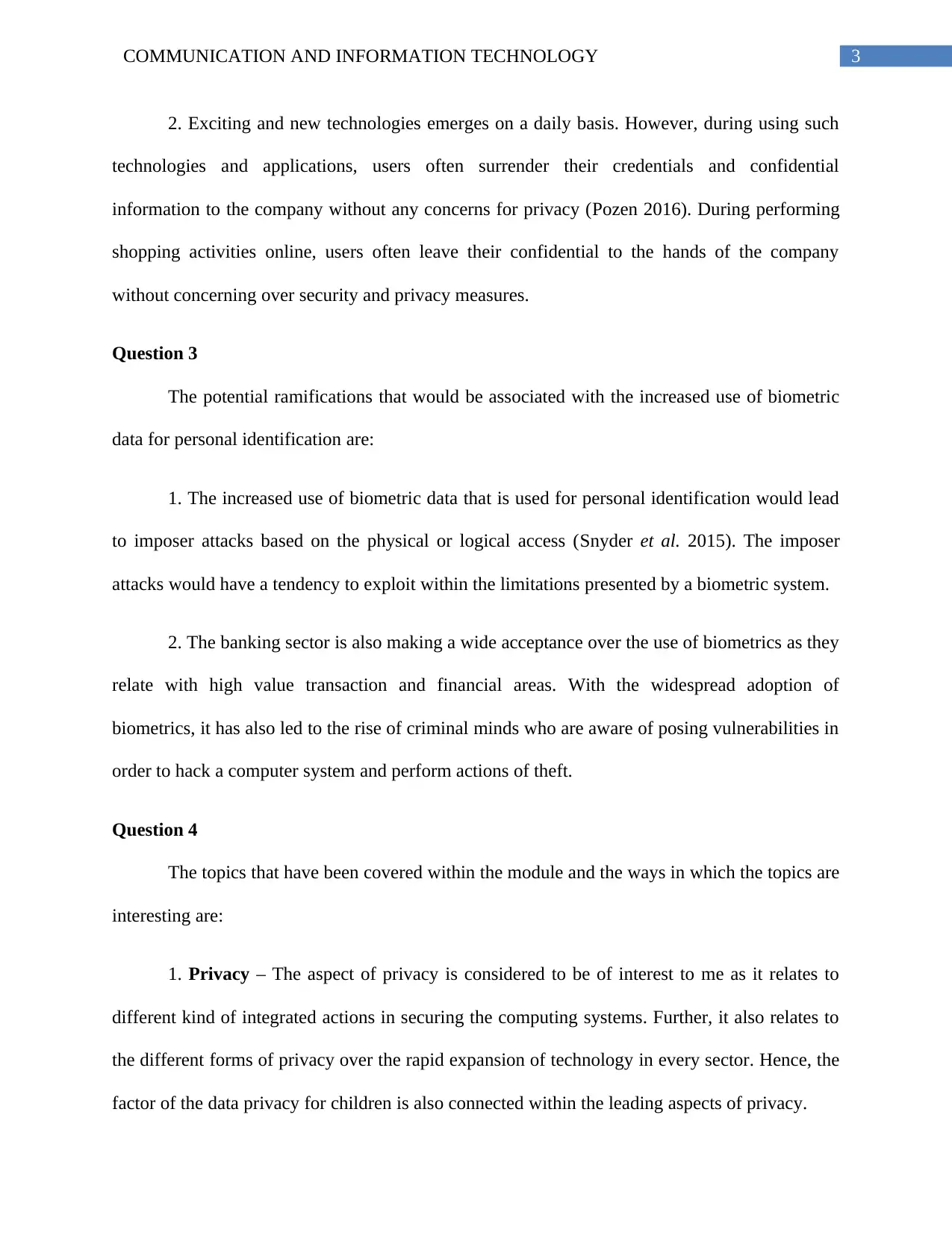
3COMMUNICATION AND INFORMATION TECHNOLOGY
2. Exciting and new technologies emerges on a daily basis. However, during using such
technologies and applications, users often surrender their credentials and confidential
information to the company without any concerns for privacy (Pozen 2016). During performing
shopping activities online, users often leave their confidential to the hands of the company
without concerning over security and privacy measures.
Question 3
The potential ramifications that would be associated with the increased use of biometric
data for personal identification are:
1. The increased use of biometric data that is used for personal identification would lead
to imposer attacks based on the physical or logical access (Snyder et al. 2015). The imposer
attacks would have a tendency to exploit within the limitations presented by a biometric system.
2. The banking sector is also making a wide acceptance over the use of biometrics as they
relate with high value transaction and financial areas. With the widespread adoption of
biometrics, it has also led to the rise of criminal minds who are aware of posing vulnerabilities in
order to hack a computer system and perform actions of theft.
Question 4
The topics that have been covered within the module and the ways in which the topics are
interesting are:
1. Privacy – The aspect of privacy is considered to be of interest to me as it relates to
different kind of integrated actions in securing the computing systems. Further, it also relates to
the different forms of privacy over the rapid expansion of technology in every sector. Hence, the
factor of the data privacy for children is also connected within the leading aspects of privacy.
2. Exciting and new technologies emerges on a daily basis. However, during using such
technologies and applications, users often surrender their credentials and confidential
information to the company without any concerns for privacy (Pozen 2016). During performing
shopping activities online, users often leave their confidential to the hands of the company
without concerning over security and privacy measures.
Question 3
The potential ramifications that would be associated with the increased use of biometric
data for personal identification are:
1. The increased use of biometric data that is used for personal identification would lead
to imposer attacks based on the physical or logical access (Snyder et al. 2015). The imposer
attacks would have a tendency to exploit within the limitations presented by a biometric system.
2. The banking sector is also making a wide acceptance over the use of biometrics as they
relate with high value transaction and financial areas. With the widespread adoption of
biometrics, it has also led to the rise of criminal minds who are aware of posing vulnerabilities in
order to hack a computer system and perform actions of theft.
Question 4
The topics that have been covered within the module and the ways in which the topics are
interesting are:
1. Privacy – The aspect of privacy is considered to be of interest to me as it relates to
different kind of integrated actions in securing the computing systems. Further, it also relates to
the different forms of privacy over the rapid expansion of technology in every sector. Hence, the
factor of the data privacy for children is also connected within the leading aspects of privacy.
Paraphrase This Document
Need a fresh take? Get an instant paraphrase of this document with our AI Paraphraser
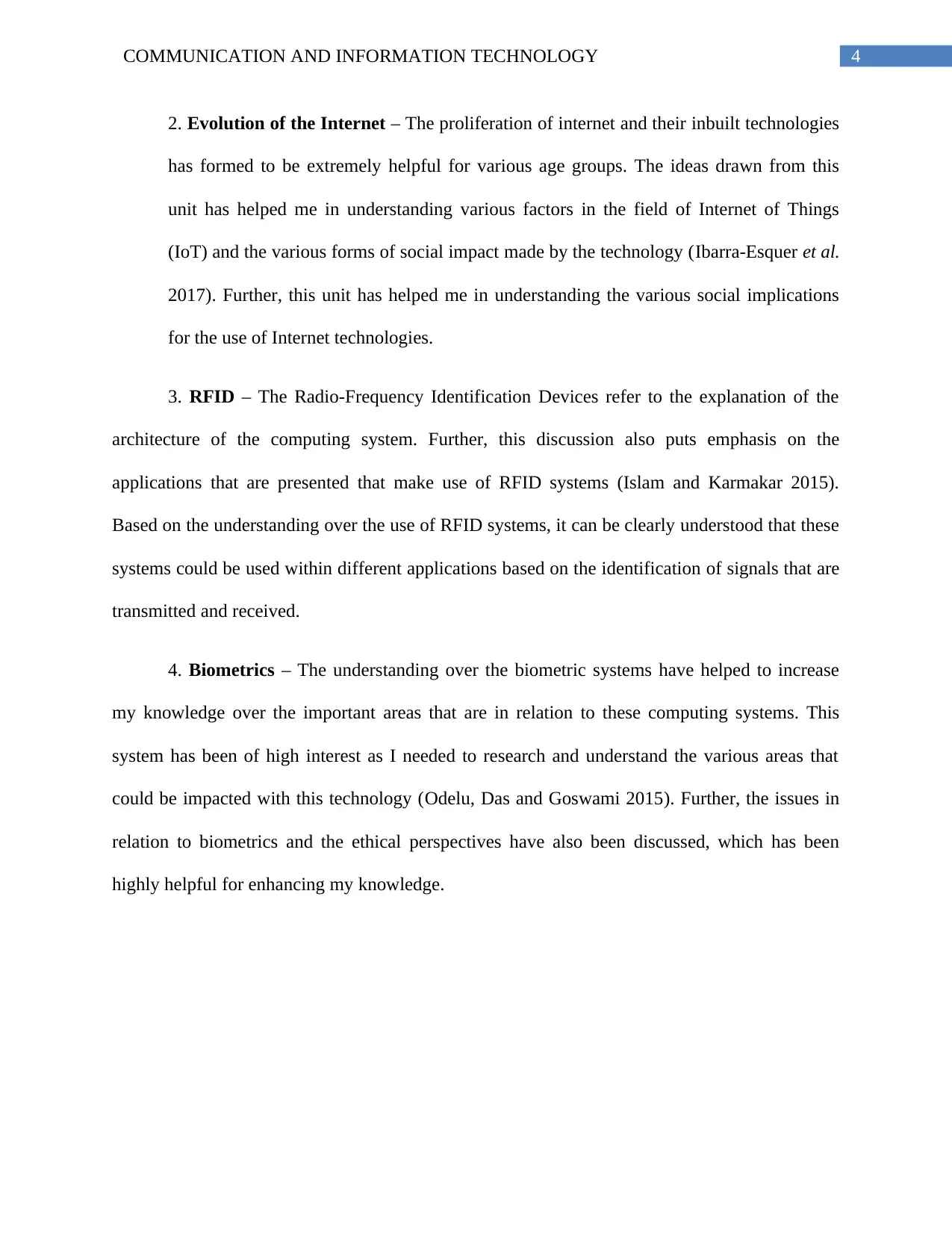
4COMMUNICATION AND INFORMATION TECHNOLOGY
2. Evolution of the Internet – The proliferation of internet and their inbuilt technologies
has formed to be extremely helpful for various age groups. The ideas drawn from this
unit has helped me in understanding various factors in the field of Internet of Things
(IoT) and the various forms of social impact made by the technology (Ibarra-Esquer et al.
2017). Further, this unit has helped me in understanding the various social implications
for the use of Internet technologies.
3. RFID – The Radio-Frequency Identification Devices refer to the explanation of the
architecture of the computing system. Further, this discussion also puts emphasis on the
applications that are presented that make use of RFID systems (Islam and Karmakar 2015).
Based on the understanding over the use of RFID systems, it can be clearly understood that these
systems could be used within different applications based on the identification of signals that are
transmitted and received.
4. Biometrics – The understanding over the biometric systems have helped to increase
my knowledge over the important areas that are in relation to these computing systems. This
system has been of high interest as I needed to research and understand the various areas that
could be impacted with this technology (Odelu, Das and Goswami 2015). Further, the issues in
relation to biometrics and the ethical perspectives have also been discussed, which has been
highly helpful for enhancing my knowledge.
2. Evolution of the Internet – The proliferation of internet and their inbuilt technologies
has formed to be extremely helpful for various age groups. The ideas drawn from this
unit has helped me in understanding various factors in the field of Internet of Things
(IoT) and the various forms of social impact made by the technology (Ibarra-Esquer et al.
2017). Further, this unit has helped me in understanding the various social implications
for the use of Internet technologies.
3. RFID – The Radio-Frequency Identification Devices refer to the explanation of the
architecture of the computing system. Further, this discussion also puts emphasis on the
applications that are presented that make use of RFID systems (Islam and Karmakar 2015).
Based on the understanding over the use of RFID systems, it can be clearly understood that these
systems could be used within different applications based on the identification of signals that are
transmitted and received.
4. Biometrics – The understanding over the biometric systems have helped to increase
my knowledge over the important areas that are in relation to these computing systems. This
system has been of high interest as I needed to research and understand the various areas that
could be impacted with this technology (Odelu, Das and Goswami 2015). Further, the issues in
relation to biometrics and the ethical perspectives have also been discussed, which has been
highly helpful for enhancing my knowledge.
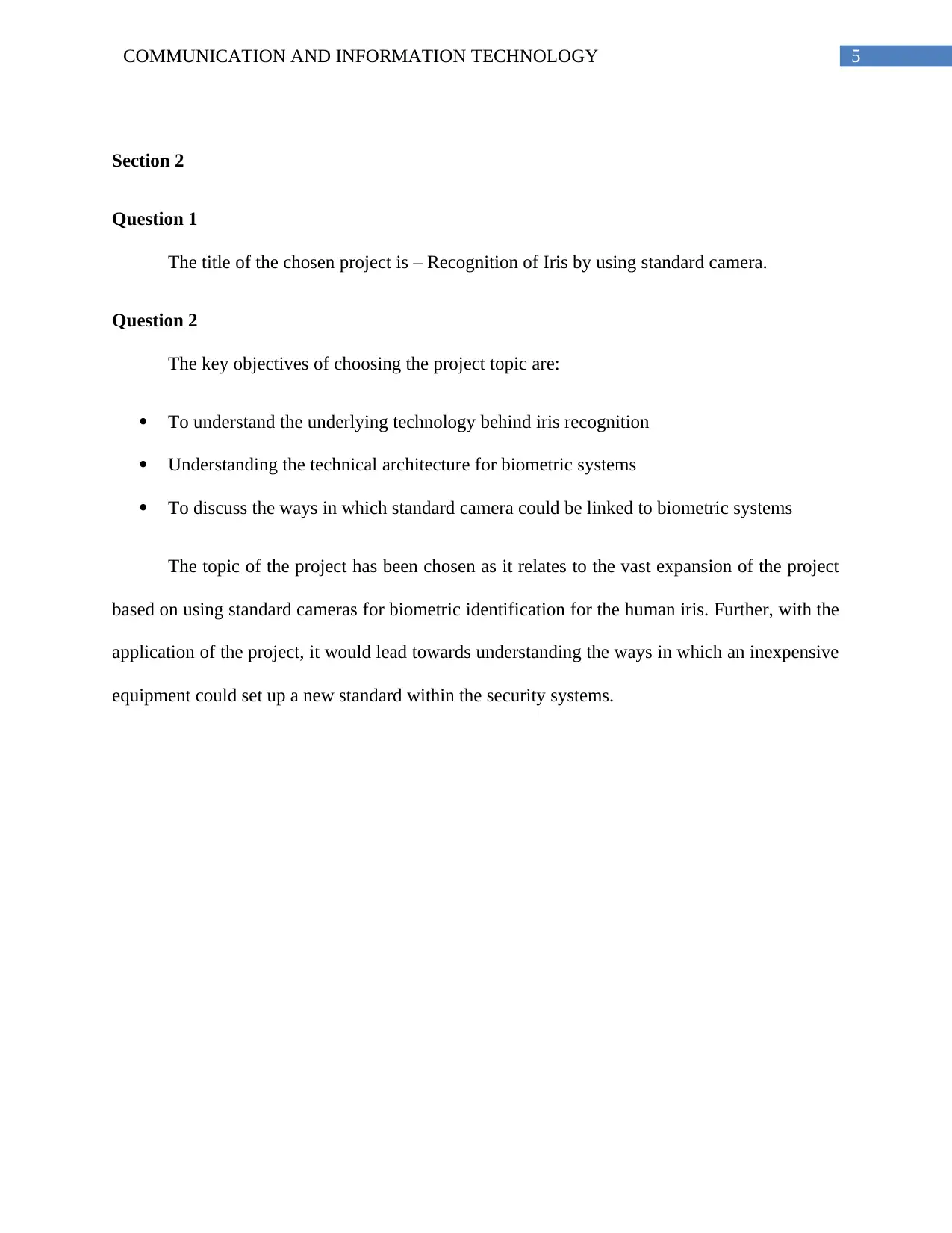
5COMMUNICATION AND INFORMATION TECHNOLOGY
Section 2
Question 1
The title of the chosen project is – Recognition of Iris by using standard camera.
Question 2
The key objectives of choosing the project topic are:
To understand the underlying technology behind iris recognition
Understanding the technical architecture for biometric systems
To discuss the ways in which standard camera could be linked to biometric systems
The topic of the project has been chosen as it relates to the vast expansion of the project
based on using standard cameras for biometric identification for the human iris. Further, with the
application of the project, it would lead towards understanding the ways in which an inexpensive
equipment could set up a new standard within the security systems.
Section 2
Question 1
The title of the chosen project is – Recognition of Iris by using standard camera.
Question 2
The key objectives of choosing the project topic are:
To understand the underlying technology behind iris recognition
Understanding the technical architecture for biometric systems
To discuss the ways in which standard camera could be linked to biometric systems
The topic of the project has been chosen as it relates to the vast expansion of the project
based on using standard cameras for biometric identification for the human iris. Further, with the
application of the project, it would lead towards understanding the ways in which an inexpensive
equipment could set up a new standard within the security systems.
⊘ This is a preview!⊘
Do you want full access?
Subscribe today to unlock all pages.

Trusted by 1+ million students worldwide
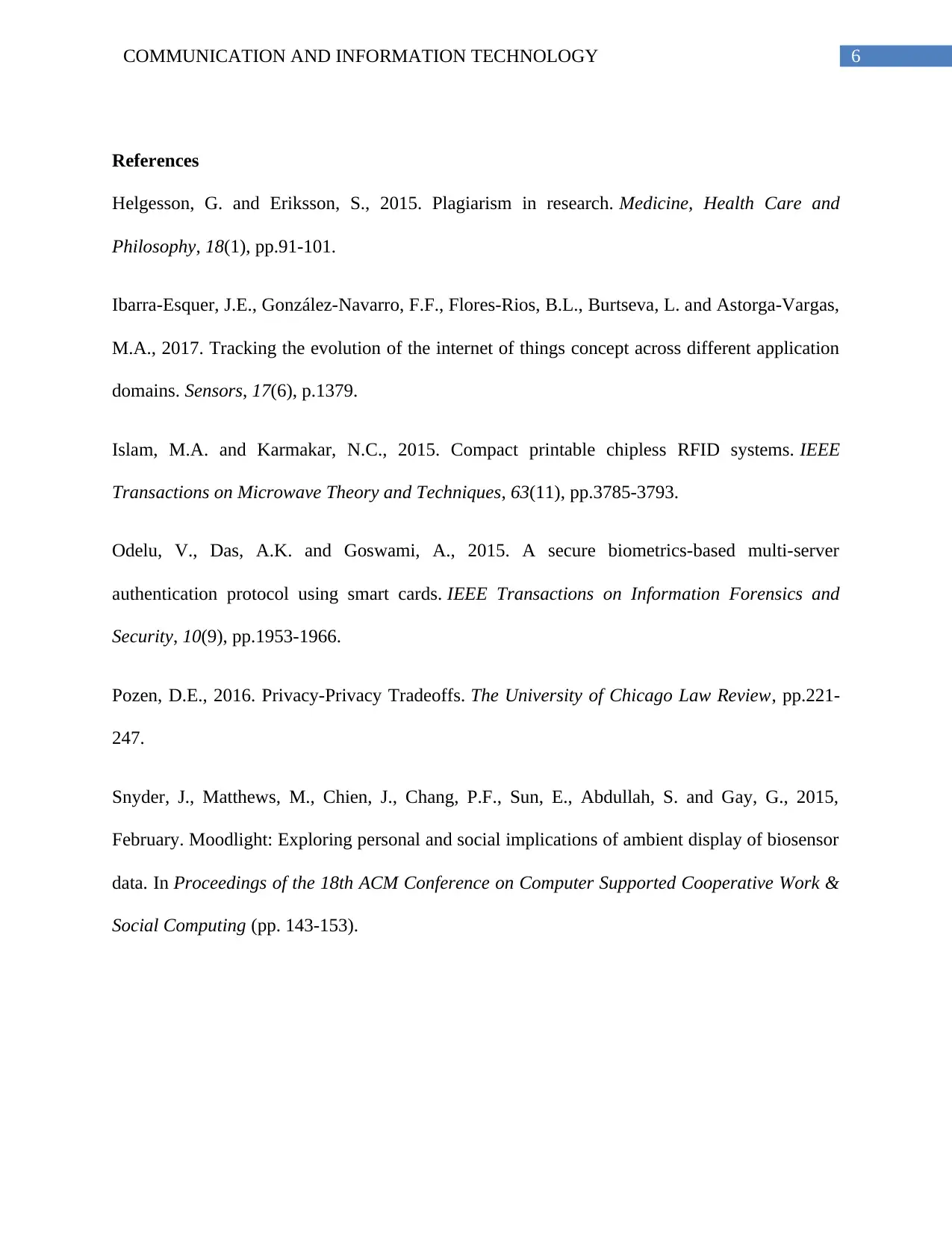
6COMMUNICATION AND INFORMATION TECHNOLOGY
References
Helgesson, G. and Eriksson, S., 2015. Plagiarism in research. Medicine, Health Care and
Philosophy, 18(1), pp.91-101.
Ibarra-Esquer, J.E., González-Navarro, F.F., Flores-Rios, B.L., Burtseva, L. and Astorga-Vargas,
M.A., 2017. Tracking the evolution of the internet of things concept across different application
domains. Sensors, 17(6), p.1379.
Islam, M.A. and Karmakar, N.C., 2015. Compact printable chipless RFID systems. IEEE
Transactions on Microwave Theory and Techniques, 63(11), pp.3785-3793.
Odelu, V., Das, A.K. and Goswami, A., 2015. A secure biometrics-based multi-server
authentication protocol using smart cards. IEEE Transactions on Information Forensics and
Security, 10(9), pp.1953-1966.
Pozen, D.E., 2016. Privacy-Privacy Tradeoffs. The University of Chicago Law Review, pp.221-
247.
Snyder, J., Matthews, M., Chien, J., Chang, P.F., Sun, E., Abdullah, S. and Gay, G., 2015,
February. Moodlight: Exploring personal and social implications of ambient display of biosensor
data. In Proceedings of the 18th ACM Conference on Computer Supported Cooperative Work &
Social Computing (pp. 143-153).
References
Helgesson, G. and Eriksson, S., 2015. Plagiarism in research. Medicine, Health Care and
Philosophy, 18(1), pp.91-101.
Ibarra-Esquer, J.E., González-Navarro, F.F., Flores-Rios, B.L., Burtseva, L. and Astorga-Vargas,
M.A., 2017. Tracking the evolution of the internet of things concept across different application
domains. Sensors, 17(6), p.1379.
Islam, M.A. and Karmakar, N.C., 2015. Compact printable chipless RFID systems. IEEE
Transactions on Microwave Theory and Techniques, 63(11), pp.3785-3793.
Odelu, V., Das, A.K. and Goswami, A., 2015. A secure biometrics-based multi-server
authentication protocol using smart cards. IEEE Transactions on Information Forensics and
Security, 10(9), pp.1953-1966.
Pozen, D.E., 2016. Privacy-Privacy Tradeoffs. The University of Chicago Law Review, pp.221-
247.
Snyder, J., Matthews, M., Chien, J., Chang, P.F., Sun, E., Abdullah, S. and Gay, G., 2015,
February. Moodlight: Exploring personal and social implications of ambient display of biosensor
data. In Proceedings of the 18th ACM Conference on Computer Supported Cooperative Work &
Social Computing (pp. 143-153).
1 out of 7
Related Documents
Your All-in-One AI-Powered Toolkit for Academic Success.
+13062052269
info@desklib.com
Available 24*7 on WhatsApp / Email
![[object Object]](/_next/static/media/star-bottom.7253800d.svg)
Unlock your academic potential
Copyright © 2020–2025 A2Z Services. All Rights Reserved. Developed and managed by ZUCOL.




